2007 HONDA PILOT height
[x] Cancel search: heightPage 19 of 319

Position the lap part of the belt as
low as possible across your hips,
then pull up on the shoulder part of
the belt so the lap part f its snugly.
This lets your strong pelvic bones
take the force of a crash and reduces
the chance of internal injuries.This spreads the f orces of a crash
over the strongest bones in your
upper body.
If the seat belt touches or crosses
your neck, or if it crosses your arm
instead of your shoulder, you need to
adjust the seat belt anchor height.
The front seats have adjustable seat
belt anchors. To adjust the height of
an anchor, press and hold the release
buttons, and slide the anchor up or
down as needed (it has f our
positions).
If necessary, pull up on the belt again
to remove any slack, then check that
the belt rests across the center of
your chest and over your shoulder.
Protecting A dults and Teens
16
RELEASE
BUTTON
Improperly positioning the seat
belts can cause serious injury
or death in a crash.
Make sure all seat belts are
properly positioned before
driving.
Page 46 of 319
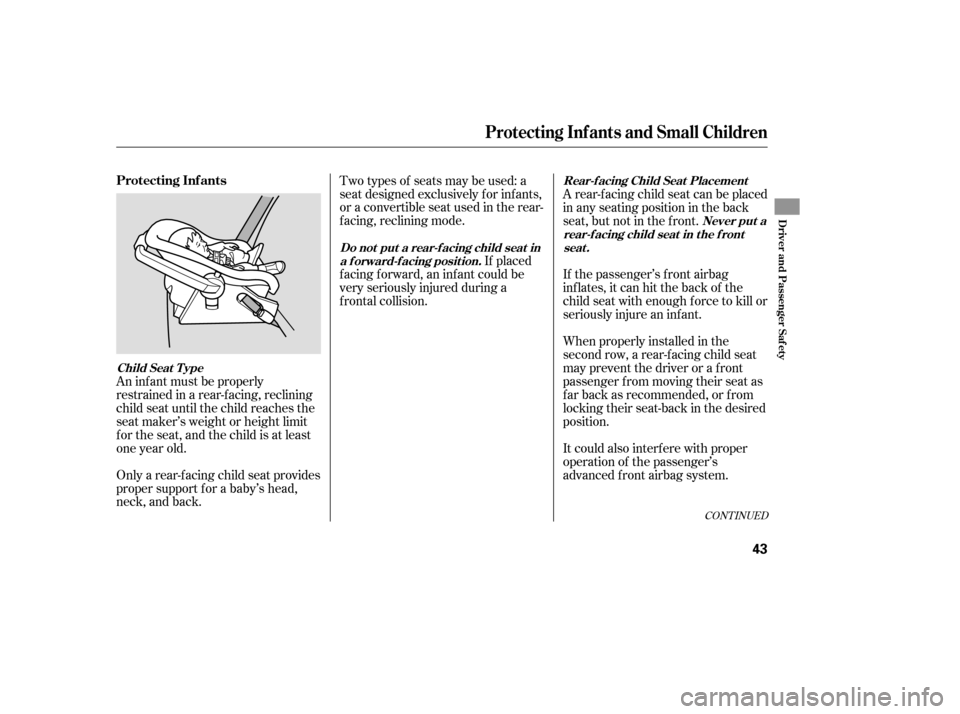
CONT INUED
An inf ant must be properly
restrained in a rear-f acing, reclining
child seat until the child reaches the
seat maker’s weight or height limit
f or the seat, and the child is at least
one year old.
Only a rear-f acing child seat provides
proper support f or a baby’s head,
neck, and back.Two types of seats may be used: a
seat designed exclusively f or inf ants,
or a convertible seat used in the rear-
f acing, reclining mode.
If placed
f acing f orward, an inf ant could be
very seriously injured during a
f rontal collision. If the passenger’s front airbag
inflates, it can hit the back of the
child seat with enough f orce to kill or
seriously injure an inf ant. A rear-f acing child seat can be placed
in any seating position in the back
seat, but not in the f ront.
When properly installed in the
second row, a rear-f acing child seat
maypreventthedriverorafront
passenger f rom moving their seat as
f ar back as recommended, or f rom
locking their seat-back in the desired
position.
It could also interf ere with proper
operation of the passenger’s
advanced front airbag system.
Protecting Inf ants and Small Children
Protecting Inf ants
Child Seat T ypeDo not put a rear-f acing child seat in
a f orward-f acing position. Rear-f acing Child Seat Placement
Never put a
rear-f acing child seat in t he f ront seat .
Driver and Passenger Saf ety
43
Page 47 of 319
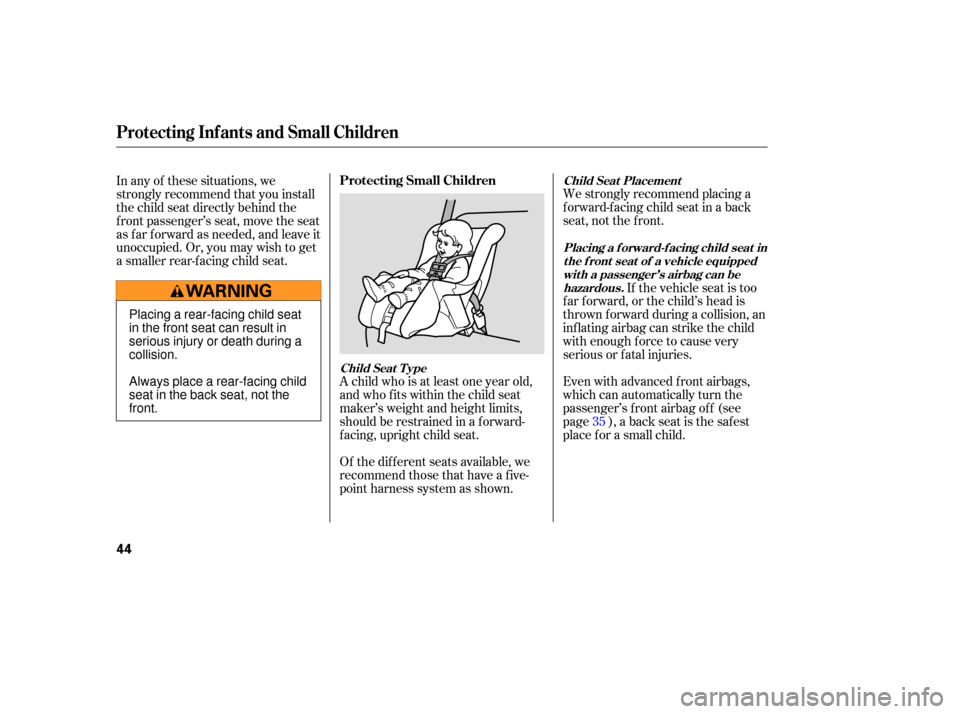
Of the different seats available, we
recommend those that have a five-
point harness system as shown. We
strongly recommend placing a
forward-fa cing child seat in a back
seat, not the front.
In
any of these situations, we
strongly recommend that you install
the child seat directly behind the
front passenger’s seat, move the seat
as far forward as needed, and leave it
unoccupied. Or, you may wish to get
a smaller rear-facing child seat.
A child who is at least one year old,
and who fits within the child seat
maker’s weight and height limits,
should be restrained in a forward-
facing, upright child seat. If
the vehicle seat is too
far forward, or the child’s head is
thro wn forward during a collision, an
infl ating airbag can strike the child
with enough force to cause very
serious or fatal injuries.
Even with advanced front airbags,
which can automatically turn the
passenger’s front airbag off (see
page ), a back seat is the saf est
place f or a small child. 35
Protecting Inf ants and Small Children
Protecting Small Children
Child Seat T ype Placing a f orward-f acing child seat in
the f ront seat of a vehicle equippedwith a passenger’s airbag can behazardous.
Child Seat Placement
44
Placing a rear-facing child seat
in the front seat can result in
serious injury or death during a
collision.
Always place a rear-facing child
seat in the back seat, not the
front.
Page 56 of 319

To determine if a lap/shoulder belt
properly f its a child, have the child
put on the seat belt, then ask
yourself :
When a child reaches the
recommended weight or height limit
for a forward-facing child seat, the
child should sit in a back seat on a
booster seat and wear a lap/shoulder
belt.
Does the child sit all the way back
against the seat?
Do the child’s knees bend
comf ortably over the edge of the
seat?
The f ollowing pages give
instructions on how to check proper
seat belt f it, what kind of booster
seat to use if one is needed, and
important precautions f or a child
who must sit in f ront.
1.
2.
CONT INUED
Checking Seat Belt Fit
Protecting L arger Children
Driver and Passenger Saf ety
53
Allowing a child age 12 or under
to sit in front can result in injury
or death if the passenger’s front
airbag inflates.
If a child must ride in front,
move the vehicle seat as far
back as possible, use a booster
seat if needed, have the child
sit up properly and wear the
seat belt properly.
Page 57 of 319
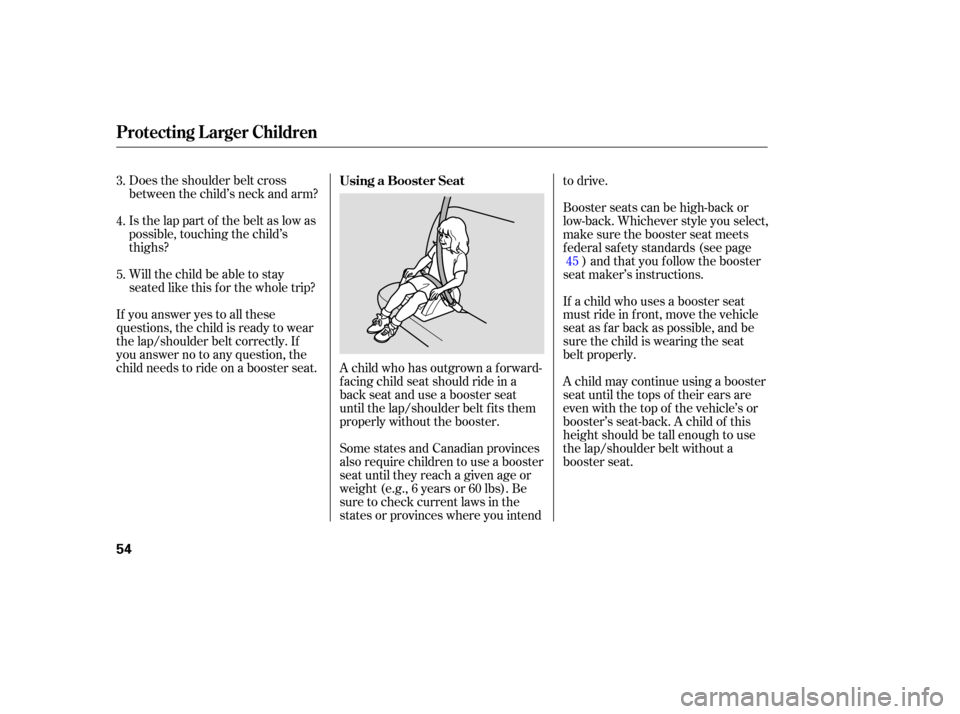
Does the shoulder belt cross
between the child’s neck and arm?
Is the lap part of the belt as low as
possible, touching the child’s
thighs?
Will the child be able to stay
seated like this for the whole trip?
If you answer yes to all these
questions, the child is ready to wear
the lap/shoulder belt correctly. If
you answer no to any question, the
child needs to ride on a booster seat. A child who has outg rown a forward-
facing child seat should ride in a
back seat and use a booster seat
until the lap/shoulder belt fits them
properly without the booster. A
child may continue using a booster
seat until the tops of their ears are
even with the top of the vehicle’s or
booster’s seat-back. A child of this
height should be tall enough to use
the lap/shoulder belt without a
booster seat.
Booster seats can be high-back or
low-back. Whichever style you select,
make sure the booster seat meets
f ederal saf ety standards (see page
) and that you f ollow the booster
seat maker’s instructions.
If a child who uses a booster seat
must ride in f ront, move the vehicle
seat as far back as possible, and be
sure the child is wearing the seat
belt properly.
Some states and Canadian provinces
also require children to use a booster
seat until they reach a given age or
weight (e.g., 6 years or 60 lbs). Be
sure to check current laws in the
states or provinces where you intend to drive.
4.
5. 3.
45
Using a Booster Seat
Protecting L arger Children
54
Page 92 of 319
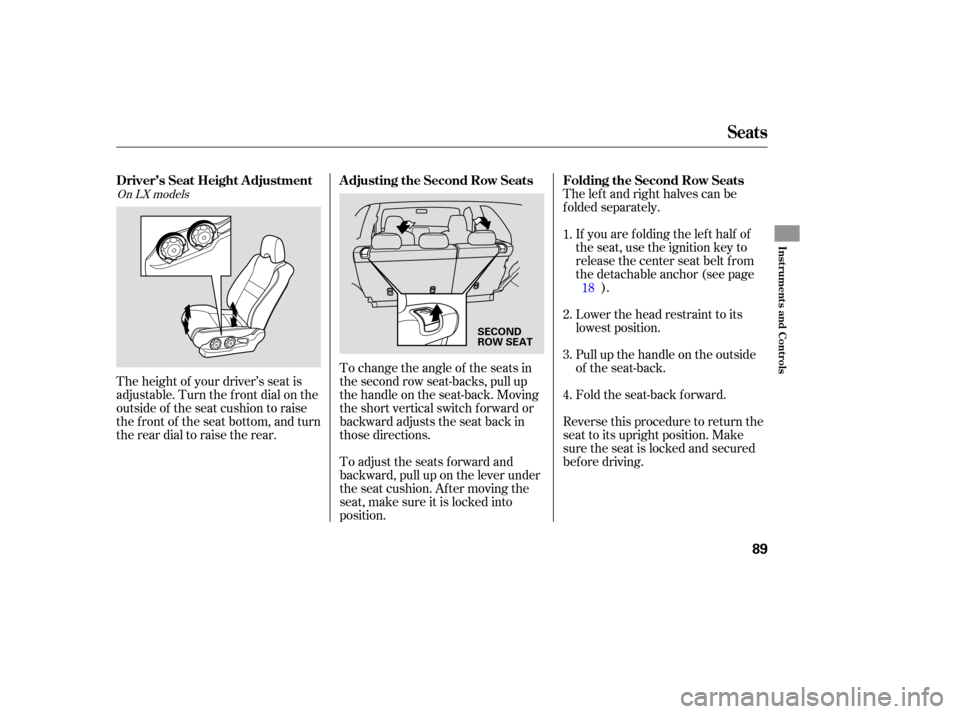
The left and right halves can be
folded separately.
If you are folding the left half of
the seat, use the ignition key to
release the center seat belt from
thedetachableanchor(seepage ).
Lower the head restraint to its
lowest position.
Pull up the handle on the outside
of the seat-back.
Fold the seat-back forward.
To change the angle of the seats in
the second row seat-backs, pull up
the handle on the seat-back. Moving
the short vertical switch f orward or
backward adjusts the seat back in
those directions.
To adjust the seats forward and
backward, pull up on the lever under
the seat cushion. Af ter moving the
seat, make sure it is locked into
position.
The height of your driver’s seat is
adjustable. Turn the front dial on the
outside of the seat cushion to raise
the front of the seat bottom, and turn
the rear dial to raise the rear.
Reverse this procedure to return the
seat to its upright position. Make
sure the seat is locked and secured
bef ore driving. 2.
3. 1.
4.18On LX models
Seats
Folding the Second Row Seats
Adjusting the Second Row Seats
Driver’s Seat Height A djustment
Inst rument s and Cont rols
89
SECOND
ROW SEAT
Page 94 of 319
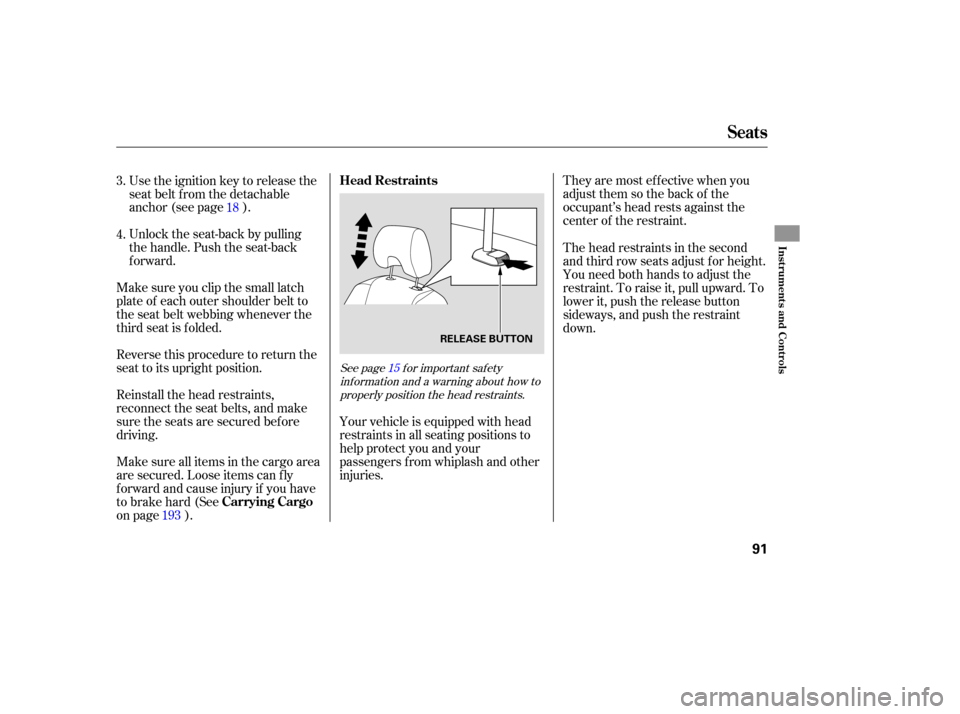
They are most effective when you
adjust them so the back of the
occupant’s head rests against the
center of the restraint.
Your vehicle is equipped with head
restraints in all seating positions to
help protect you and your
passengers from whiplash and other
injuries.
Use
the ignition key to release the
seat belt from the detachable
anchor (see page ).
Unlock the seat-back by pulling
the handle. Push the seat-back
forward.
Make sure you clip the small latch
plate of each outer shoulder belt to
the seat belt webbing whenever the
third seat is folded.
Reverse this procedure to return the
seat to its upright position.
Reinstall the head restraints,
reconnect the seat belts, and make
sure the seats are secured before
driving.
Ma ke sure all items in the cargo area
are secured. Loose items can fly
forward and cause injury if you have
to brake hard (See
on page ). The
head restraints in the second
and third row seats adjust for height.
You need both hands to adjust the
restraint. To raise it, pull upward. To
lower it, push the release button
sideways, and push the restraint
down.
3.
4.
18
193
See page f or important saf ety inf ormation and a warning about how toproperly position the head restraints. 15
Seats
Head Restraints
Carrying Cargo
Inst rument s and Cont rols
91
RELEASE BUTTON
Page 223 of 319

Your vehicle tires and spare are
properly inflated, and the trailer
tires and spare are inflated as
recommended by the trailer
maker.
To wing performance can be
affected by high altitude, high
te mperature, or when climbing
steep grades. Therefore, premium
fuel (premium unleaded gasoline
wi th pump octane number of 91 or
higher) is recommended when
towing more than 3,500 lbs (1,590
kg).
The added weight, length, and
height of a trailer will affect your
vehicl e’s handling and performance,
so driving with a trailer requires
some special driving skills and
techniques. Foryoursafetyandthesafetyof
others,taketimetopracticedriving
maneuvers
before heading for the
open road, and follow the guidelines
below.
Avoid towing a trailer during your
vehicle’s f irst 600 miles (1,000 km)
(see page ).
Drive slower than normal in all
driving situations, and obey posted
speed limits f or vehicles with trailers.
When towing a f ixed-sided trailer
(e.g., camper), do not exceed 55 mph
(88 km/h). At higher speeds, the
trailer may sway or affect vehicle
handling.
To prevent the transmission f rom
shif ting f requently, drive in the D
position. Maketurnsmoreslowlyandwider
than normal. The trailer tracks a
smaller arc than your vehicle, and it
canhitorrunoversomethingthe
vehicle misses. Allow more time and
distance f or braking. Do not brake or
turn suddenly as this could cause the
trailer to jackknif e or turn over.
When climbing hills, closely watch
your temperature gauge. If it nears
the red (Hot) mark, turn the air
conditioning of f , reduce speed and, if
necessary, pull to the side of the
road to let the engine cool.
If the automatic transmission shif ts
f requently while going up a hill, shif t
to D .
186
3
Trailer Driving Tips
Driving Saf ely With a T railer
Break-In Period
T owing Speeds and Gears Making T urns and Braking
Driving on Hills
220